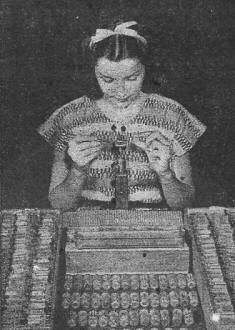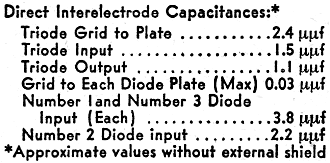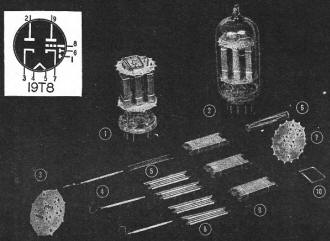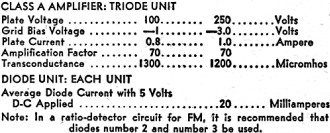New Tube Improves FM
|
|
General Electric's 19T8 vacuum tube was more than just a high frequency diode-triode component for use in the upper radio and television circuits. It also included a dual-diode element which was physically associated with the cathode of the triode side of the tube. It is meant to be used in combination AM / FM receivers operating up to 100 MHz. Its 18.9 V heater voltage is higher than the much more common 6.3 V and 12.6 V levels (note integer multiples of 6.3, including 25.2V sometimes used). From the limited information I could find about the 19T8, it was not as widely used as the 6T8, which used a more typical 6.3 V heater element. I also could not locate any direct replacements for the 19T8 by any other company. Evidently GE tried to start a trend that nobody else was willing to follow. New Tube Improves FM - Cover Feature The 19T8 and similar tubes are designed for high frequencies. Successful circuits for FM depend on tubes which work well at frequencies near 100 mc. Among the new tubes designed to improve FM reception are the 19T8, assembly of which is illustrated on our cover this month. Its 6.3-volt counterpart, the 6T8, and the 12AT7 are other tubes especially designed for FM, and were announced at the same time by the General Electric Co. Table I - 19T8 vacuum tube interelectrode capacitance specifications. Model 19T8 vacuum tube components. Table II - Characteristics and typical operation for Class A amplifier. The new tube consists of 3 sections, one of which contains a triode, while the other two have 2 diodes and 1 diode respectively. Shields around the diodes are identical in appearance with the triode plate, giving the appearance of a triple-triode tube. Operating skill in assembling tubes takes on new importance with the increasing complexity of these multielement, high-frequency units. The size of the tube is decreased though the number of elements in it is increased. The per son whose skillful fingers put together the various parts of the tube becomes an important factor in FM progress. Economical production demands that these complex tubes be constructed to rigid specifications with a minimum of rejected tubes. The 19T5 is identical to the 6T8 tube except for the difference in filament voltage, which is 18.9 at 0.15 amp in the 19T8 and 6.3 volts at 0.45 amp in the 6T8. Designed for use as a combined AM and FM detector and audio-frequency amplifier, it contains 3 high-perveance diodes and a high-mu triode in the same envelope. One of the diodes has a separate cathode connection. Small size, internal isolation and shielding and low interelectrode capacitances adapt the tube to high-frequency operation. Its diameter is 7/8 inch and the height of the glass envelope is 1 15/16 inches, the over-all height with prongs being 2 13/16 inches. Internal capacitances are given in Table 1. Typical operating characteristics are given in Table 2. The tube has the new 9-pin base. An excellent idea of its internal construction is given in the exploded view photograph, in which 1 is a completely assembled tube without the glass envelope and 2 is the completed tube. The top mica separator is shown at 3, the cathodes at 4, and the triode grid at 5. The plates marked 8 are anodes for the diodes (in one case a shield), while those marked 9 are the plate of the triode circuit and shields for the 2 diode sections. A glass tube containing filaments appears at 6, the bottom separator at 7, and a piece holding the getter strip at 10. Announced at the same time as the 19T8, the 12AT7 is a miniature twin triode designed for use as a grounded-grid, radio-frequency amplifier or as a frequency converter at frequencies below approximately 300 mc. A center-tapped heater permits operation of the tube from either a 6.3 or 12.6-volt heater supply. Table II-Characteristics and Typical Operation
Posted November 20, 2020 |
|





